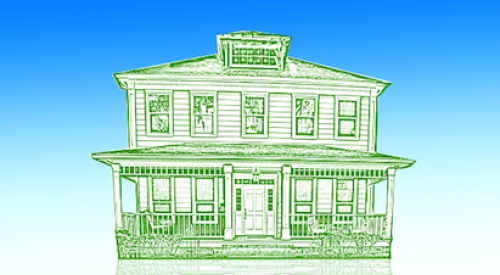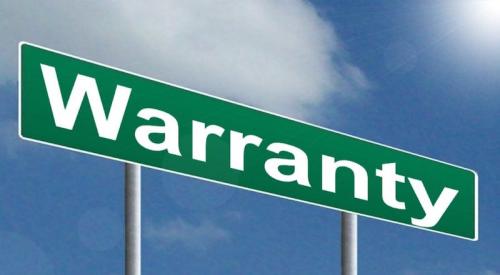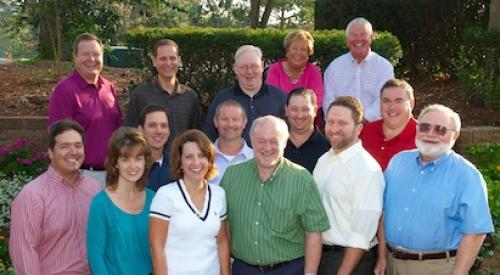Consider a few facts about the Phoenix home building market. For the last two years, the city has consistently ranked number one or two in total starts, just ahead or just behind Atlanta. It’s a red-hot housing market that is hyper competitive. No builder--and there are many--has more than a 10% market share.
| Shea Homes Arizona president Buddy Satterfield (front) believes that the virtual organization it has created with its TradePartners offers the greatest opportunity for improved efficiency and customer satisfaction. |
Succeeding in this environment means standing apart from the crowd. The survivor--the victor--is the one who can attract people committed to delivering the highest quality product to the buyer. Creating a corporate culture where innovation and excellence is institutionalized rather than just encouraged is critical. Just as imperative is extending this culture beyond the company to include everyone involved in delivering a home. It is then that the bigger the payoffs, the better--for the builder and the buyer.
This year’s National Housing Quality gold award winner has mastered culture creation. In fact, Shea Homes Arizona has moved beyond just creating a culture and instead started to create a virtual organization. In this atmosphere there is a new focus between the company, its employees and its trade partners. Rather than dwell on who does what, attention is centered on what is the best way to accomplish the task at hand.
| Shea superintendents and TradePartners work together to ensure construction quality on the job site. Each partner reviews the work of the those that have gone before them, while the superintendent performs visual inspections as well. |
While the shift may sound subtle, the results have been anything but. Shea’s overall customer satisfaction rating in 1998 was 87%, up one percentage point from the previous year. Sales from customer referrals in the same year were 18%, a 3% increase over 1997. Seventy-six percent of the company’s homes were delivered defect-free at buyer orientation, an 8% improvement over the previous year. Building days—the weighted average number of days for all series homes from trench to city final inspection--dropped to 112, an 11-day improvement over 1997 averages.
For Shea Homes these are the tangible, bottom-line benefits of quality management. However, just as important are things less quantifiable--employee satisfaction, growth and retention; and trade partner participation in the company’s quality initiatives. To management’s way of thinking, success in these "soft" areas is critical if Shea is to reach its goal of being best in class--both locally and nationally.
"People build the houses," says Shea president Buddy Satterfield. "That is where our efforts must begin."
The beginning is training for all associates and trade partners. The foundation training is Stephen Covey’s Seven Habits of Highly Effective People curriculum. "It makes everyone more receptive to all that comes later," explains Satterfield. "These practices are also the verbs that help our organization put our values into action."
| Continuous training is the foundation of Shea Home Arizona’s corporate culture. Every employee develops a personal training plan with their supervisor as part of the annual review process. |
For every Shea new hire, a training schedule is set for the first 12 months. Beyond the seven habits coursework, orientation training includes an introduction to performance excellence; customer service certification; the accounting game, which encourages employees to work as business owners would; and exchange programs with their closest internal customer in order to develop an understanding of internal and external customer interactions. Employees and their managers, as part of Shea’s annual goal planning and career development process, create additional training schedules--both in-house and externally.
"The development of our employees is vital to our success," says Shea vice president/human resources Joyce Manigold. "We want satisfied and skilled people who are dedicated to the goals and success of the Shea culture."
Hub And Spoke
This commitment extends to Shea’s trade contractors, always known as TradePartners, a term the company believes in so strongly it has trademarked the title. "These people are the lifeline of Shea Homes, not only because they supply the building materials, but also because their craftspeople actually construct the homes," explains Paul Kalkbrenner, vice president/construction. "They aren’t subcontractors; they are an extension of Shea and treated as such."
| "Our goal is to implement quality in a way that will make a difference to our goals." -- Shea Homes Arizona president Buddy Satterfield |
Combine this attitude with TradePartner training and the result is a transformation in the way Shea builds homes. However, before there could be improvement, there had to be an understanding of the current construction process. Together, the two groups met to define the construction process.
They agreed upon a four-phase process review:
- Phase I--layout to frame complete
- Phase II--frame complete to stucco lath
- Phase III--stucco lath to countertops
- Phase IV--countertops to orientation
In Phase I, Shea director of training Russ Johnston worked with the three TradePartners involved in this phase--framers, plumbers and the concrete trade--and broke the construction process down to its smallest components. After six to eight months of work, they identified 96 unique steps involved in Phase I. The exercise also taught them that the current construction model wasn’t working. For instance, the concrete worker would come in, do some work, and leave. The framer would follow suit. Both would have to come back later in the process because the workflow wasn’t designed so all aspects of the job could be done in one trip.
"It was a hub and spoke relationship," explains Satterfield. "Shea Homes was the hub and all the TradePartners were the spokes. Information would go from Shea out on a spoke to a TradePartner and come back on a spoke. This happened with every trade. This structure put up barriers in communication from trade to trade and actually seemed to encourage them not to work or talk with each other."
Once the problem was identified, the solution was obvious: Eliminate the hub and spoke communication model and replace it with a process flow. "We redesigned the entire way we work," says Johnston. "Now, each TradePartner comes to the site the fewest number of times. Information about job readiness and job complete is shared from trade to trade rather than from Shea Homes to the TradePartner."
"Shea created a situation where all of us could come together and talk honestly about the work we do without any fear or hurt feelings," explains framer Jim Younger, Younger Brothers Construction. "In that environment we all could get beyond our own jobs and responsibilities and see a better way to work."
The results of this win-win group are dramatic and on going. The number of steps in Phase I dropped from 96 to 64 and then fell again to 43--a 55% reduction. Cycle time has dropped 39%, from 19.4 to 11.5 working days. The number of trades involved in this phase also is less. Today the electrical trade is no longer involved in Phase I. The concrete TradePartner handles one phase of the electrician’s work while the plumber handles another.
Beyond just understanding the process, an additional key segment of the new workflow is trade-friendly plans that are lot and trade specific. The outcome of this change has been fewer errors and reworks overall.
Another component of this process re-engineering is the three quality assurance process points established by the win-win group. Trade workers in concrete, plumbing and framing inspect work done by the previous TradePartner based on a list of criteria to determine compliance. Any non-compliance is referred to the process owner at the root cause. Any worker can stop the line if necessary.
"Our intent is to create a defect-free product at all phases," explains Kalkbrenner. "TradePartners now recognize that they are accountable to each other and not just to Shea. It’s a better work environment for everyone."
Customer Expectations
Delivering a defect-free home in a shorter period of time is but one component of Shea’s plan to move as many of its buyers as possible to that evangelical state--where they are out "selling" Shea Homes to family and friends because they are so happy with their own. In fact, experience has taught Shea that managing customer expectations of and during the home building and buying process is just as critical as doing the work right and on time.
"Our approach has been to process-map the entire home buying process from the customer’s point of view," explains Shea sales and marketing department head Bob Crandall. "This allows us to determine the critical customer contact points and reinforce them with what the buyer needs to know."
Initially, a Shea customer receives a tote bag with a notebook, including dividers, for each contact point in the process, i.e., design center, mortgage company, etc. At each of these points, Shea personnel contact the buyer to provide assistance. Some of the material presented to educate homebuyers includes:
- Homebuyer Video: Given to each homebuyer at the time of site selection and purchase, this covers every aspect of the home buying process, including construction of the home itself.
- Quality Sale Checklist: The sales counselor reviews 19 critical items with the buyer, including the purpose of the video, zoning of surrounding areas, home construction delivery date and financing.
- Pre-Construction Meeting: The sales counselor introduces the buyer to the superintendent so that they can develop a working relationship, set expectations and address concerns prior to start of construction.
- Information Letters: Six information letters are sent just prior to each of the critical points in the home buying process to better prepare the customer for the next step.
- Options Walk: Provides an opportunity for the superintendent and buyer to discuss any concerns or address any questions.
- Pre-Orientation List: The homebuyer creates a list of construction concerns, which gives the superintendent an opportunity to resolve issues prior to orientation to assure customer satisfaction.
- Pre-Signing: Feedback from buyers indicated extreme stress on the day they took possession of the home. To help alleviate the stress, much of the paperwork is reviewed and signed prior to the final day’s orientation.
- Orientation: The superintendent introduces homeowners to their new home and demonstrates the amenities and answers questions regarding maintenance and efficient operation.
- Warranty Manual: The user-friendly manual adopts a question and answer format with cartoons, highlights of key points and even a glossary of terms.
- Follow-Up After Close: The sales counselor calls the homeowner to make sure there are no outstanding issues. The sales counselor visits the customer with a welcome gift, and the superintendent contacts the homeowner to see if all is as expected. Any problems are quickly addressed.
Full Circle
Process improvements at Shea Homes are only as good as the data that backs them up. Shea management measures nearly everything: employee satisfaction, TradePartner satisfaction, and the most measured of all--customer satisfaction. To determine just how well it’s living its vision of "enhancing people’s lives through the construction of the finest homes and communities in America," Shea relies on several customer satisfaction gauges, including:
- Employee Focus Groups: Feedback is solicited from superintendents, warranty superintendents and sales counselors on a regular basis.
- Homeowner Focus Groups: Small groups of Shea homeowners help the company determine what is important to the customer, and as a result, how it can improve.
- Home Buyer Survey Results: A formal survey is conducted with every homeowner following close of escrow to determine satisfaction. Results are tallied and trended over time. The average return rate on the survey is 55% to 60%.
- Intro-Call Response: A third party personally calls every new homeowner to determine the level of satisfaction and identify any areas of dissatisfaction.
- Service Performance Survey: Following a warranty/service calls, approximately 200 homeowners are contacted each month to determine the level of satisfaction or complaints. The plan is to do this after every warranty request in the near future.
- Competitors’ Survey: On an annual basis, Shea’s home buyer survey is sent to homeowners of the top 15 builders to determine their satisfaction level. Ratings are tallied and compared to Shea’s rating in each category.
This wealth of data is explored and analyzed by the customer service process improvement team (PIT). Made up of representatives from all areas in the company, this PIT determines which products, processes, and services need improvement. Their job is to identify, prioritize, plan and measure any improvement efforts, either directly or through another team or work group.
"Our goal is to implement quality in a way that will make a difference to our goals," explains Satterfield. "The only way to do that is to get our people involved in the process and let them drive it. They’re the believers now. They have an idea, implement it and then tell us about it later. This was a little scary at first but there is no arguing with the results."
Also See:
Triple Crown Sets Mark for Public Responsibility
Drees Leads by Letting Go












